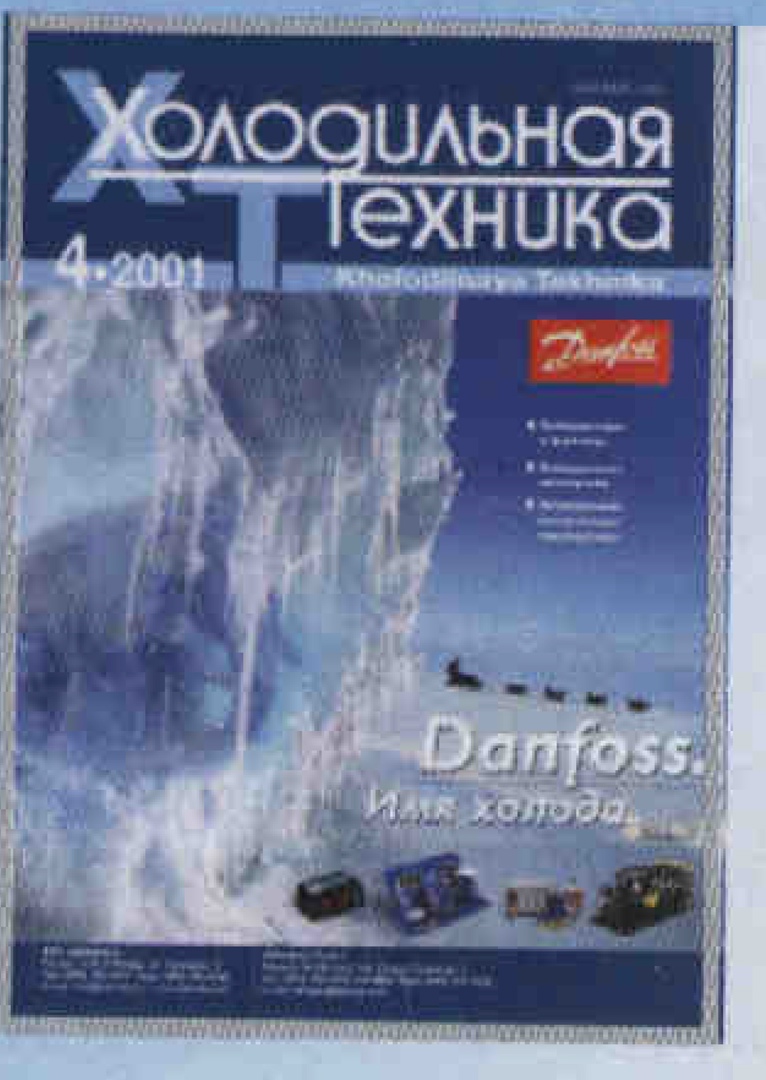Том 90, № 4 (2001)
Статьи
Санкт- Петербургский государственный университет низкотемпературных и пищевых технологий: в XXI век с новыми надеждами
Аннотация
Курс руководства страны на индустриализацию и бурный рост холодильного хозяйства С С С Р в 20 -30 -е годы предопределил необходимость создания единого учебного и научного центра, который обеспечил бы развивающуюся промышленность специалистами-холодильщиками. 31 мая 1931 г. Совет народных комиссаров СССР по становлением № 431 открыл в Ленинграде в здании бывшего коммерческого учили ща постройки 1872 г. по Чернышеву переулку, дом 9 центр по холодильной технике -Ленинградский учебный механико-технологический холодильный комбинат, объединивший институт, рабфак и техникум.
 2-3
2-3


 4-7
4-7


Кафедра кондиционирования воздуха
Аннотация
В 1947 г. в институте была основана кафедра сани гарной техники. Первые два года ее возглавлял профессор А.Н.Будняков, а с 1948 по 1967 г. — профессор Р. М. Ладыженский, при котором с 1961 г. она стала именоваться кафедрой кондиционирования воздуха, санитарной техники и охраны труда.
 8-9
8-9


Кафедра холодильных установок
Аннотация
Кафедра «Холодильные установки» была организована в 1933 г. после разделения кафедры «Холодильные машины и установки», которую возглавлял с 1931 г. чл.-кор. АН СССР А.А. Саткевич. Создание новой кафедры было обусловлено возросшей потребностью быстроразвивающихся отраслей пищевой промышленности и холодильного хозяйства в инженерных кадрах в области производства и применения искусственного холода.
 10-11
10-11


Кафедра криогенной техники
Аннотация
В 50-х годах XX века основанных отраслях науки и техники начались интенсивное развитие новых технологий, в значительной степени связанных с использованием криогенных температур. Это относится В первую очередь к таким отраслям, как металлургия, химия и ракетно-космически техника. Для работы в них потребовались инженерные кадры, имеющие необходимые знания в области криогеники.
 12-15
12-15


Перспективы создания типоразмерных рядов холодильных машин и тепловых насосов на базе унифицированных осевых компрессоров
Аннотация
Осевые компрессоры, отличающиеся от центробежных значительно более высокой энергетической эффективностью и практически вытеснившие их из авиа моторостроения и энергетических силовых газотурбинных установок, крайне редко применяют в холодильной технике, а также в воздушных и газовых компрессорных установках, используемых в промышленности.
 16-18
16-18


Холодоснабжение систем кондиционирования в восстановленном храме Христа Спасителя в Москве
Аннотация
830-х годах было взорвано здание храма Христа Спасителя и на его месте началось строительство высотного здания Дворца Советов.
Был вырыт огромный котлован и сооружены металлические конструкции основания фундамента высотного здания. В начале Великой Отечественной войны строительство было прекращено, металлические конструкции были срезаны и использованы как противотанковые заграждения при обороне Москвы. После окончания войны строительство Дворца Советов не возобновили, а на месте котлована построили открытый плавательный бассейн.
В середине 90-х годов при активном участии мэра Москвы Ю.М.Лужкова было принято решение о ликвидации бассейна и восстановлении на этом месте храма Христа Спасителя. Проектными и архитектурными работами по воссозданию храма руководил директор института «Моспроект-2» М.М. Посохин
 27-29
27-29


Отечественные приборы для холодильного оборудования
Аннотация
Холодильная промышленность развивается сегодня в нашей стране довольно быстрыми темпами. Августовский кризис 1998 г., в результате которого резко сократились поставки импортной холодильной техники, пошел на пользу отечественным производителям. Это оживило российские заводы по производству торгового холодильного оборудования. С развитием различных форм торговли, в том числе и виртуальной, выросла потребность в холодильных камерах, охлаждаемых витринах и прилавках, в передвижных холодильных установках и кондиционерах.
 30-32
30-32


Система охлаждения компрессоров Bitzer с помощью управляемого впрыска хладагента (CIC)
Аннотация
Использование хладагента R22 вместо R502 в низкотемпературном холодильном оборудовании связано с необходимостью выполнения ряда специальных требований к конструкции компрессора и холодильному маслу. При повышении давления конденсации R22 температура нагнетания может быстро достичь недопустимых значений. При длительной эксплуатации в таких условиях стабильность масла в смеси с хладагентом падает и, как следствие, снижается срок службы компрессора. Снизить температуру нагнетания удается путем применения специальной системы охлаждения, использующей управляемый впрыск жидкого хладагента во всасывающую полость компрессора. Применительно к компрессорам Bitzer такая система получила название CIC (Controlled Injection Cooling). В распоряжении потребителя появился надежный способ ограничивать температуру нагнетания в четырех- и шестицилиндровых поршневых компрессорах
 36-37
36-37


Абсорбционные бромистолитиевые преобразователи теплоты нового поколения
Аннотация
Абсорбционные преобразователи теплоты (АПТ) представляют собой термодинамическую систему, осуществляющим трансформацию теплоты с высокотемпературного уровня на низко температурный (понижающий АПТ) и, наоборот, с низкотемпературного уровня на более высокий (повышающий АПТ) с помощью совмещенных прямого и обратного циклов.
 18-20
18-20


Современные проблемы эксплуатации аммиачных холодильных систем и пути их решения
Аннотация
Этой актуальной теме был посвящен состоявшийся 14-17 ноября 2000 г. семинар, организованный учебным комбинатом «Холод» (находящимся в ведении ОАО «Росмясомолторг») для главных инженеров и начальников компрессорных цехов пищевых предприятий и хладокомбинатов.
На семинаре присутствовали представители хладокомбината ст. Узловая, Смоленского, Жуковского, Калужского, Воронежского, Саратовского хладокомбинатов, а также правления ОАО «Росмясомолторг», научно-исследовательских и проектных организаций, вузов, фирм и т. д.
 38-38
38-38


Холодильные машины для охлаждения жидкости (чиллеры) с полугерметичными аммиачными компрессорами Грассо Интернэшнл
Аннотация
На базе поршневых полугерметичных аммиачных компрессоров Лоизводства фирмы «Грассо» (завод в г. Халле, Германия) создано семейство холодильных машин для охлаждения жидкостей (чиллеров с широким диапазоном производительности: от 115 до 1549 кВт. Совместные исследования специалистов фирм «Грассо» и «Синс» позволили разработать специальный электродвигатель, устойчивый к воздействию аммиака, повышенной влажности и холодильных масел, пригодный для применения в полугерметичных машиачных компрессорах «Грассо» уникальной конструкции.
 39-39
39-39


 46-46
46-46









